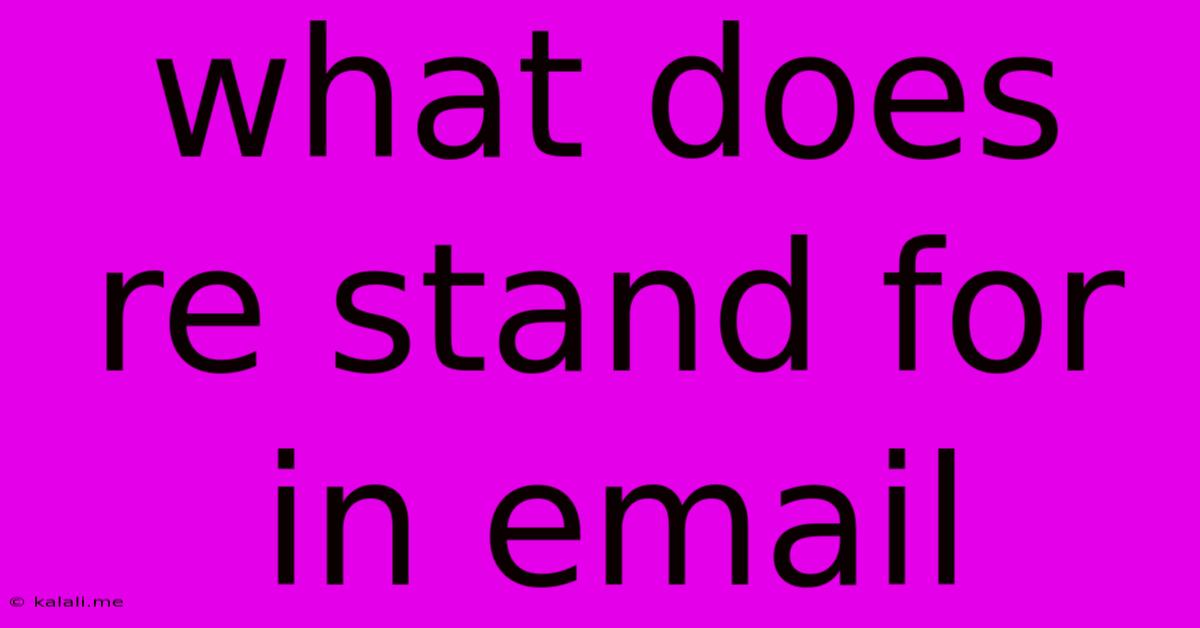What Does Re Stand For In Email
Kalali
Jun 01, 2025 · 3 min read

Table of Contents
What Does RE Stand For in Email? A Comprehensive Guide to Email Etiquette
So, you've received an email with "RE:" in the subject line. But what does it actually mean? This seemingly simple question can actually unlock a deeper understanding of email etiquette and efficient communication. In short, RE stands for "Reply." This simple abbreviation signifies that your email is a response to a previous message. This article will delve deeper into the nuances of using RE in your emails, covering its purpose, best practices, and how it contributes to clear and effective communication.
Understanding the "RE" in email communication is essential for maintaining organized inboxes and fostering professional interactions. Whether you're a seasoned email user or just starting out, understanding the subtle etiquette surrounding email replies can make a significant difference in your communication effectiveness.
The Purpose of "RE" in Email Subjects
The primary purpose of using "RE" in your email subject line is to provide context. It instantly tells the recipient that your email is a direct response to a previous message. This is particularly helpful when dealing with multiple email threads or discussions. Without the "RE," the recipient might struggle to identify the context of your message, especially if their inbox is cluttered. Using "RE" creates a clear chain of communication, making it easier to follow the conversation's flow.
Best Practices for Using "RE" and "FWD"
While "RE" signifies a reply, "FWD" stands for "Forward." It's important to understand the difference. "RE" is used when you're replying directly to the sender, while "FWD" is used when you're sending a message to someone else, usually copying them into an existing conversation. Both are crucial elements of professional email communication and should be used appropriately. Here are some best practices:
- Be concise: Keep your subject line concise and relevant to the conversation. Avoid unnecessarily long subject lines.
- Use RE appropriately: Only use "RE" when you are directly replying to the sender of the original email.
- Use FWD appropriately: Only use "FWD" when forwarding an email to a third party who was not originally involved in the conversation. Consider adding a brief explanation of why you're forwarding the email.
- Maintain context: Add context to your replies, especially when multiple conversations are happening simultaneously.
- Edit subject lines: When necessary, update the subject line to reflect the current focus of the discussion. This improves readability and clarity.
Beyond "RE": Refining Your Email Communication
While understanding "RE" is fundamental, effective email communication extends beyond this basic abbreviation. Consider these additional tips for improved email etiquette:
- Use clear and concise language: Avoid jargon and ambiguity.
- Proofread your emails: Check for spelling and grammatical errors before sending.
- Use professional tone: Maintain a courteous and respectful tone in all your email communications.
- Respond promptly: Aim to reply to emails within a reasonable timeframe.
- Organize your inbox: Utilize folders and filters to manage your email effectively.
Mastering the use of "RE" and employing these additional best practices will significantly improve your email communication skills, making you a more efficient and professional communicator. By understanding and implementing these strategies, you'll not only improve your own productivity but also contribute to smoother and more effective communication with others.
Latest Posts
Latest Posts
-
How Did Xavier Lose His Legs
Jun 03, 2025
-
How To Turn On A Bicycle Light
Jun 03, 2025
-
Why Did My Ac Unit Freeze Up
Jun 03, 2025
-
Gas Furnace Keeps Shutting Off And Needs To Be Reset
Jun 03, 2025
-
Guitar Hero Warriors Of Rock
Jun 03, 2025
Related Post
Thank you for visiting our website which covers about What Does Re Stand For In Email . We hope the information provided has been useful to you. Feel free to contact us if you have any questions or need further assistance. See you next time and don't miss to bookmark.